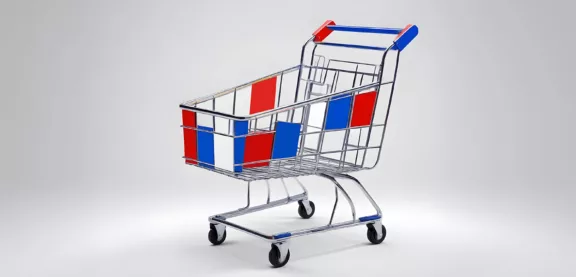Ambitious, solution-orientated, pragmatic and realistic – that’s how our customers know us. And we remained true to these principles in our search for the relevant trends and topics for 2022. It’s not about jumping on every new digital hype. Rather, the whole thing can be seen as a guideline. This should help you make informed decisions and operate responsibly and sustainably. In line with our aspirations, we have put together four articles on nine topics that you simply cannot avoid in 2022. D2C direct marketing and marketing automation as well as the upcoming post-cookie era have one thing in common: the direct line to the customer is becoming increasingly important. In the second part of our digital trends 2022, we evaluate and assess these topics: What is already taking flight? And what is just taking off?
D2C Direct Marketing | Take off
The direct line to target groups is becoming increasingly important. Companies need to examine the extent to which direct-to-consumer approaches can help to meet challenges such as the end of third-party cookies in 2022.

It is no understatement to say that the pandemic represents the ultimate loss of control. And it seems reasonable to assume that this is one of the reasons why D2C – direct to consumer or direct marketing – has made its way into this outlook. But that is only part of the truth.
What does D2C mean?
By D2C, or direct-to-consumer, we mean the direct sale of products or services by the manufacturer. This means that companies that were previously purely active in B2B and sold their products to intermediaries now come into direct contact with the end customer themselves. For example, via their own online shop. In doing so, they exclude intermediaries (at least partially) from the value creation process. This integration of upstream or, as in this example, downstream stages of the value creation process is also known as verticalisation. Even if this naturally involves costs, direct marketing offers clear advantages:
- There is control over the business relationship with the end customer
- The manufacturer can achieve higher margins as sales do not have to be shared.
- Brand touchpoints can be better controlled
- There is direct access to customer data
So the interpreted need to cushion a loss of control is quite obvious. However, we see the relevance much more on other levels.
Why can D2C help?
Direct marketing offers a solution to many of the challenges or topics described in this series of articles: The important trust of stakeholders, data and knowledge about customers, increasingly complex customer journeys or communication via audio content. Direct contact with customers, knowledge of their needs and the ability to address them directly are important foundations for solving challenges or seizing opportunities.
For 2022, this means that companies need to gain clarity about which advantages of D2C direct marketing are relevant for their own company and how their own company is positioned in the field of tension between opportunities and risks.
Of course, for many companies, switching to a D2C approach also means changing structures and power relationships that have evolved over time. They also have to actively shape the direct customer relationship themselves, which requires new expertise. In a company’s own online shop, contact with customers must ultimately be organised by the company itself, while long-standing sales partners suddenly no longer participate in value creation.
Marketing Automation | Flies
Your target groups' demands for digital communication and experiences have increased. in 2022, you should consider how you can continue to serve highly individualized customer journeys in a targeted manner – and how you can prepare your employees for this.

We are all characterised by digital experiences that implicitly shape our expectations of brand touchpoints. In almost two years of the pandemic, Amazon, Netflix and Google have set the bar very high. However, this must also be met in B2B in 2022. Here, too, digital touchpoints must now function more than ever without direct human contact. Especially at the beginning of a customer relationship. This is because the majority of buyers now only speak to sales once a decision has already been made. The demand for information and the purely digital experience in advance is correspondingly high.
The future is hybrid
In addition to digital channels, the use of analogue channels has also increased again (insofar as the incidence figures have allowed). And in parallel, without a reduction in digital usage. We therefore see the future in hybrid experiences that allow a free choice of channel and combine the best of both worlds, online and offline. Personalised omnichannel communication is also gaining new relevance in B2B, while at the same time increasing the complexity of the approach. It is no longer just a matter of seamlessly connecting many digital channels, unnoticed by customers: analogue touchpoints must also become part of a perfect, consistent experience.
Internal consequences
These external developments have internal consequences: complexity is increasing. If you want to continue to communicate seamlessly and purposefully at every touchpoint, you need automated processes. In 2022, companies will therefore have to focus intensively on the automation of marketing and sales processes. This will help with the management of customer-related business processes, such as addressing and retaining customers.
At the same time, target groups are moving across internal departmental boundaries within their respective journeys: they expect perfect hybrid experiences. They don’t care whether marketing or sales is responsible for them. They expect their digital and analogue expectations to be met perfectly.
This means that companies can no longer afford to think internally in silos in order to create a seamless hybrid experience.
Post-cookie era | Takes off
Data is the basis for targeted and relevant communication with your target groups. With your own data strategy, you are not only perfectly equipped, you will also benefit from the trust gained from your stakeholders.

As customers, we often have a paradoxical relationship with data. We value the relevance of content that is made possible by personalisation. At the same time, none of us probably like sharing our data. In response to this behaviour, major tech companies, above all Google, have heralded the end of third-party cookies in 2023. For companies, this means that in order to continue working with relevant data, 2022 must be used to shape the change from third-party to first-party data. This means that companies can no longer rely on external data – they must collect their own.
Decisive: the human factor
In addition to the technical aspects of this change, the human factor in particular is receiving new attention. Because in order to be able to work with data-driven marketing in the future, target groups need to co-operate. As mentioned at the beginning: Who likes to share their data?
In order to be prepared for this change, Deloitte has identified four key aspects for the way forward:
- A good customer relationship is the basis for everything. Without trust, everything is nothing. A direct line to customers is therefore an essential success factor.
- Companies must hand over control to consumers, for example through opt-in options.
- Privacy and security aspects must be included right from the start in order not to lose the trust that has been painstakingly earned.
- It must be communicated simply and clearly.
2022 will therefore be the year in which companies will have to compete anew for the trust of their stakeholders. Or would you share data with someone you don’t trust?






